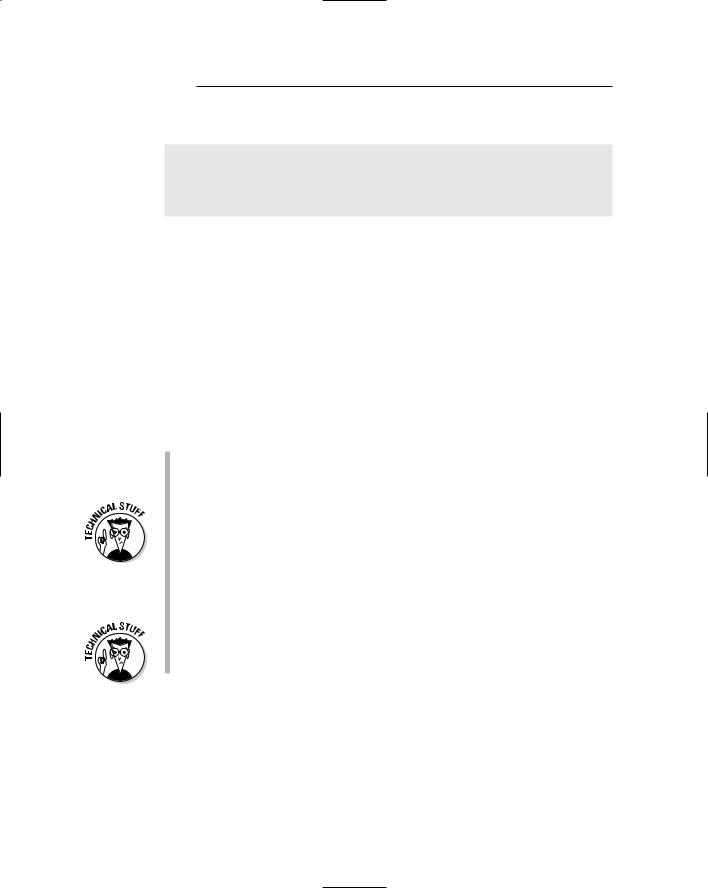
- •Table of Contents
- •Introduction
- •About This Here Dummies Approach
- •How to Work the Examples in This Book
- •Foolish Assumptions
- •Icons Used in This Book
- •Final Thots
- •The C Development Cycle
- •From Text File to Program
- •The source code (text file)
- •The compiler and the linker
- •Running the final result
- •Save It! Compile and Link It! Run It!
- •Reediting your source code file
- •Dealing with the Heartbreak of Errors
- •The autopsy
- •Repairing the malodorous program
- •Now try this error!
- •The Big Picture
- •Other C Language Components
- •Pop Quiz!
- •The Helpful RULES Program
- •The importance of being \n
- •Breaking up lines\ is easy to do
- •The reward
- •More on printf()
- •Printing funky text
- •Escape from printf()!
- •A bit of justification
- •Putting scanf together
- •The miracle of scanf()
- •Experimentation time!
- •Adding Comments
- •A big, hairy program with comments
- •Why are comments necessary?
- •Bizarr-o comments
- •C++ comments
- •Using Comments to Disable
- •The More I Want, the More I gets()
- •Another completely rude program example
- •And now, the bad news about gets()
- •The Virtues of puts()
- •Another silly command-prompt program
- •puts() and gets() in action
- •More insults
- •puts() can print variables
- •The Ever-Changing Variable
- •Strings change
- •Running the KITTY
- •Hello, integer
- •Using an integer variable in the Methuselah program
- •Assigning values to numeric variables
- •Entering numeric values from the keyboard
- •The atoi() function
- •So how old is this Methuselah guy, anyway?
- •Basic mathematical symbols
- •How much longer do you have to live to break the Methuselah record?
- •The direct result
- •Variable names verboten and not
- •Presetting variable values
- •The old random-sampler variable program
- •Maybe you want to chance two pints?
- •Multiple declarations
- •Constants and Variables
- •Dreaming up and defining constants
- •The handy shortcut
- •The #define directive
- •Real, live constant variables
- •Numbers in C
- •Why use integers? Why not just make every number floating-point?
- •Integer types (short, long, wide, fat, and so on)
- •How to Make a Number Float
- •The E notation stuff
- •Single-character variables
- •Char in action
- •Stuffing characters into character variables
- •Reading and Writing Single Characters
- •The getchar() function
- •The putchar() function
- •Character Variables As Values
- •Unhappily incrementing your weight
- •Bonus program! (One that may even have a purpose in life)
- •The Sacred Order of Precedence
- •A problem from the pages of the dentistry final exam
- •The confounding magic-pellets problem
- •Using parentheses to mess up the order of precedence
- •The computer-genie program example
- •The if keyword, up close and impersonal
- •A question of formatting the if statement
- •The final solution to the income-tax problem
- •Covering all the possibilities with else
- •The if format with else
- •The strange case of else-if and even more decisions
- •Bonus program! The really, really smart genie
- •The World of if without Values
- •The problem with getchar()
- •Meanwhile, back to the GREATER problem
- •Another, bolder example
- •Exposing Flaws in logic
- •A solution (but not the best one)
- •A better solution, using logic
- •A logical AND program for you
- •For Going Loopy
- •For doing things over and over, use the for keyword
- •Having fun whilst counting to 100
- •Beware of infinite loops!
- •Breaking out of a loop
- •The break keyword
- •The Art of Incrementation
- •O, to count backward
- •How counting backward fits into the for loop
- •More Incrementation Madness
- •Leaping loops!
- •Counting to 1,000 by fives
- •Cryptic C operator symbols, Volume III: The madness continues
- •The answers
- •The Lowdown on while Loops
- •Whiling away the hours
- •Deciding between a while loop and a for loop
- •Replacing those unsightly for(;;) loops with elegant while loops
- •C from the inside out
- •The Down-Low on Upside-Down do-while Loops
- •The devil made me do-while it!
- •do-while details
- •The always kosher number-checking do-while loop
- •Break the Brave and Continue the Fool
- •The continue keyword
- •The Sneaky switch-case Loops
- •The switch-case Solution to the LOBBY Program
- •The Old switch-case Trick
- •The Special Relationship between while and switch-case
- •A potentially redundant program in need of a function
- •The noble jerk() function
- •Prototyping Your Functions
- •Prototypical prototyping problems
- •A sneaky way to avoid prototyping problems
- •The Tao of Functions
- •The function format
- •How to name your functions
- •Adding some important tension
- •Making a global variable
- •An example of a global variable in a real, live program
- •Marching a Value Off to a Function
- •How to send a value to a function
- •Avoiding variable confusion (must reading)
- •Functions That Return Stuff
- •Something for your troubles
- •Finally, the computer tells you how smart it thinks you are
- •Return to sender with the return keyword
- •Now you can understand the main() function
- •Give that human a bonus!
- •Writing your own dot-H file
- •A final warning about header files
- •What the #defines Are Up To
- •Avoiding the Topic of Macros
- •A Quick Review of printf()
- •The printf() Escape Sequences
- •The printf() escape-sequence testing program deluxe
- •Putting PRINTFUN to the test
- •The Complex printf() Format
- •The printf() Conversion Characters
- •More on Math
- •Taking your math problems to a higher power
- •Putting pow() into use
- •Rooting out the root
- •Strange Math? You Got It!
- •Something Really Odd to End Your Day
- •The perils of using a++
- •Oh, and the same thing applies to a --
- •Reflections on the strange ++a phenomenon
- •On Being Random
- •Using the rand() function
- •Planting a random-number seed
- •Randoming up the RANDOM program
- •Streamlining the randomizer
- •Arrays
- •Strings
- •Structures
- •Pointers
- •Linked Lists
- •Binary Operators
- •Interacting with the Command Line
- •Disk Access
- •Interacting with the Operating System
- •Building Big Programs
- •Use the Command-Line History
- •Use a Context-Colored Text Editor
- •Carefully Name Your Variables
- •Breaking Out of a Loop
- •Work on One Thing at a Time
- •Break Up Your Code
- •Simplify
- •Talk through the Program
- •Set Breakpoints
- •Monitor Your Variables
- •Document Your Work
- •Use Debugging Tools
- •Use a C Optimizer
- •Read More Books!
- •Setting Things Up
- •The C language compiler
- •The place to put your stuff
- •Making Programs
- •Finding your learn directory or folder
- •Running an editor
- •Compiling and linking
- •Index

302 Part IV: C Level
What the #defines Are Up To
The #define directive is another one of those things the compiler eats before it works on your source code. Using #define, you can set up some handy, clever, and memorable word equivalents to big numbers, constant values, or just about anything that appears in your C source code.
The full scope of the #define “construction” is offered in Chapter 8. Because I’m on an anti-redundancy campaign, I don’t repeat it here. Let me add, how ever, that #define is the most popular item placed into a header file. Edit your HEAD.H file, in fact, and add these two lines:
#define TRUE 1
#define FALSE (!TRUE)
Save HEAD.H back to disk with these modifications.
What you have done is to create a shortcut word, TRUE, that you can use as a “true” condition.
The FALSE shortcut word is defined as being “not” true. The exclamation point in C means not. The value of FALSE is obviously !TRUE. (It works out to be 0; no big deal.)
To make immediate use of the two new shortcut words, modify the source code for HTEST.C:
#include <stdio.h> #include “head.h”
int main() SPIT
if(TRUE)
BLECH(“Must be true!\n”); if(FALSE)
BLECH(“Never see this message.\n”); return(0);
SPOT
Carefully type this source code into your editor. Save it to disk. Compile. Run.
The output looks something like this:
Must be true!

Chapter 23: The Stuff That Comes First 303
The best time for using the TRUE or FALSE shortcut words is when you create a while loop. Refer to Chapters 17 and 18.
In the C language, the value 1 is taken to be TRUE, and 0 is FALSE.
Some C programmers prefer to define TRUE and FALSE this way:
#define FALSE 0
#define TRUE(!FALSE)
Whatever. This book defines TRUE as 1 and FALSE as “not true,” which works out to 0. If you see the preceding #defines in a program, every thing still works as advertised. Just don’t let it throw you.
Some compilers may issue a warning message when no comparison is in the if statement’s parentheses. That’s just the compiler being smart again; it recognizes the certainty of the if keyword’s “comparison” and tells you whether it is always TRUE or is always FALSE.
Some compilers may also point out that the second if statements are never executed because the if condition is always false. Big deal. Run the program anyway.
Avoiding the Topic of Macros
Another # thing used in the C language is the macro. Like #include and #define, macros are instructions to the compiler that tell it how to handle conditions and whether specific parts of the source code are to be used or skipped. Weird, but handy.
Though there’s no reason to describe in detail what macros are and because I’m not crazy enough to waste time with an example, you may see even more pound-sign goobers playing the macro game in someone else’s C source code. Pick any from this list:
#if
#else
#endif
#ifdef
#ifndef
These are also instructions to the C compiler, designed primarily to indicate whether a group of statements should be compiled or included with the final program.

304 Part IV: C Level
For example:
#if GRAPHICS
//do graphical wonders here
#else
//do boring text stuff here #endif
Suppose that GRAPHICS is something defined earlier in the program or in a header file — #define GRAPHICS 1, for example. If so, the compiler com piles the statements only between the #if GRAPHICS and #else lines.
Otherwise, the statements between #else and #endif are compiled. The result? Potentially two different programs using one source code.
Crazy! Why bother?
I have used this trick only once: I wrote a program that had two versions — one that ran on old color PC systems and a second that ran on monochrome systems. On the color PCs, I had statements that displayed text in color, which didn’t work on the old monochrome monitors. Therefore, I used the #if goober so that I needed to write only one source code file to create both versions of the program.
There’s really no need to bother with this stuff. I’m mentioning it here because it fits in the section heading and because some C poohbah somewhere would chastise me for ignoring it.
The #if thing is followed by a shortcut word defined elsewhere in the
program with the #define construction. If it’s value isn’t 0, the #if con dition is true and the statements between #if and #endif are compiled. Oh, and there’s an #else in there too, which serves the same purpose as the C language else word.
You may see some of the #ifdef or #ifndef things in various header files. I have no idea what they’re doing in there, but they look darn impressive.
Another #-goober is #line. It’s rarely used. Supposedly, what it does is force the compiler to report a unique line number just in case an error occurs. (Don’t worry — I don’t get it either.)

Chapter 24
The printf() Chapter
In This Chapter
Using printf() to display text
Displaying forbidden characters with escape sequences
Displaying the values of variables
Understanding conversion characters
Perhaps one of the most familiar fellows you have met on your C pro gramming journey is the printf() function. Though you may have been
using it, and despite my various and sundry hints about some of its power, I don’t feel that you have really been formally introduced. Now, after all that time, this chapter is your formal introduction to the full power of printf().
A Quick Review of printf()
You should know three printf() tricks:
printf() displays the text you put inside the double quotes.
printf() requires the backslash character — an escape sequence — to display some special characters.
printf() can display variables by using the % conversion character.
The % conversion characters can also be used to format the output of the information that’s printed.
